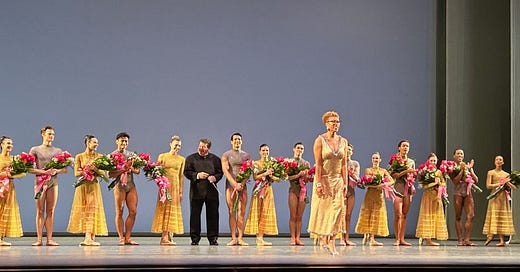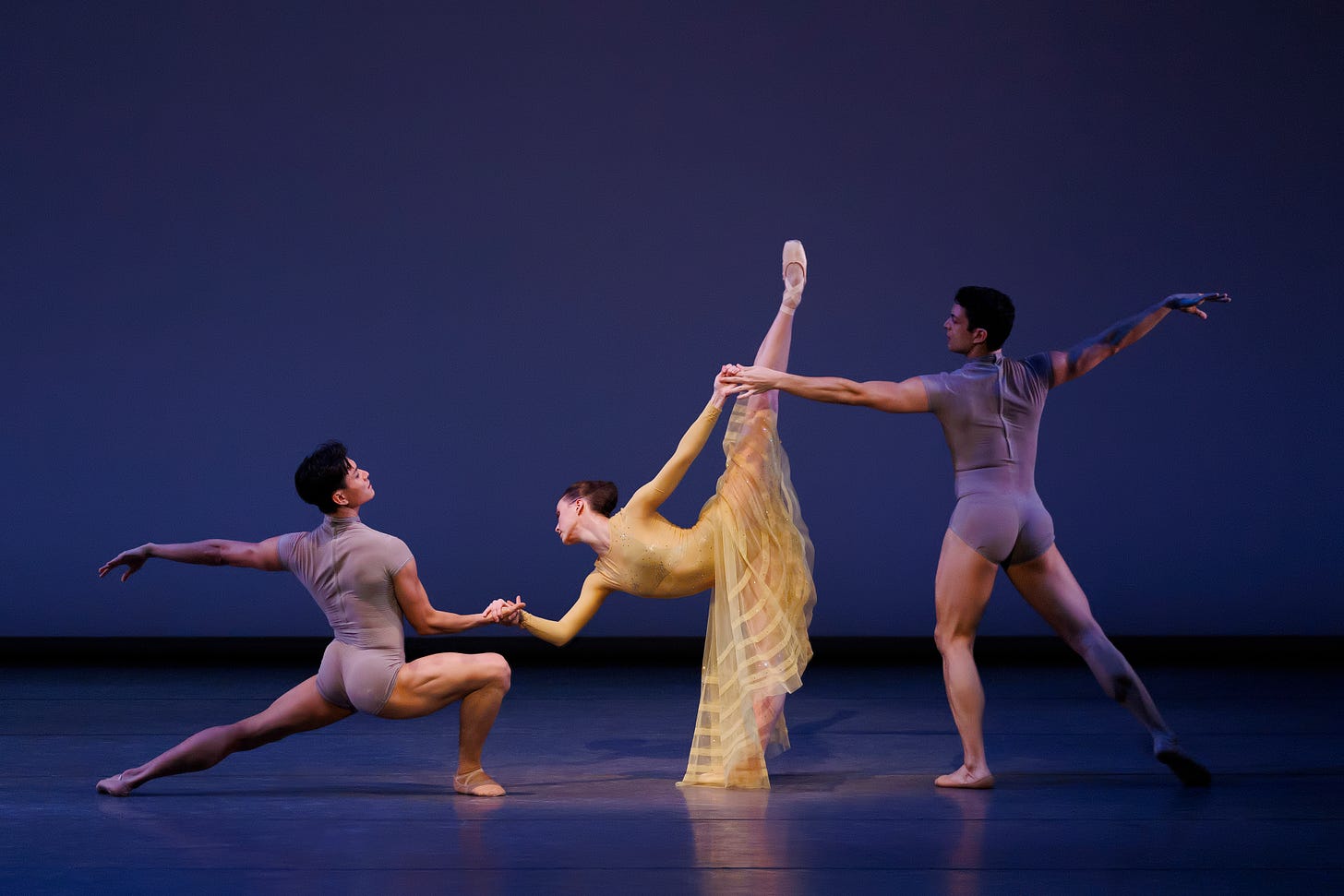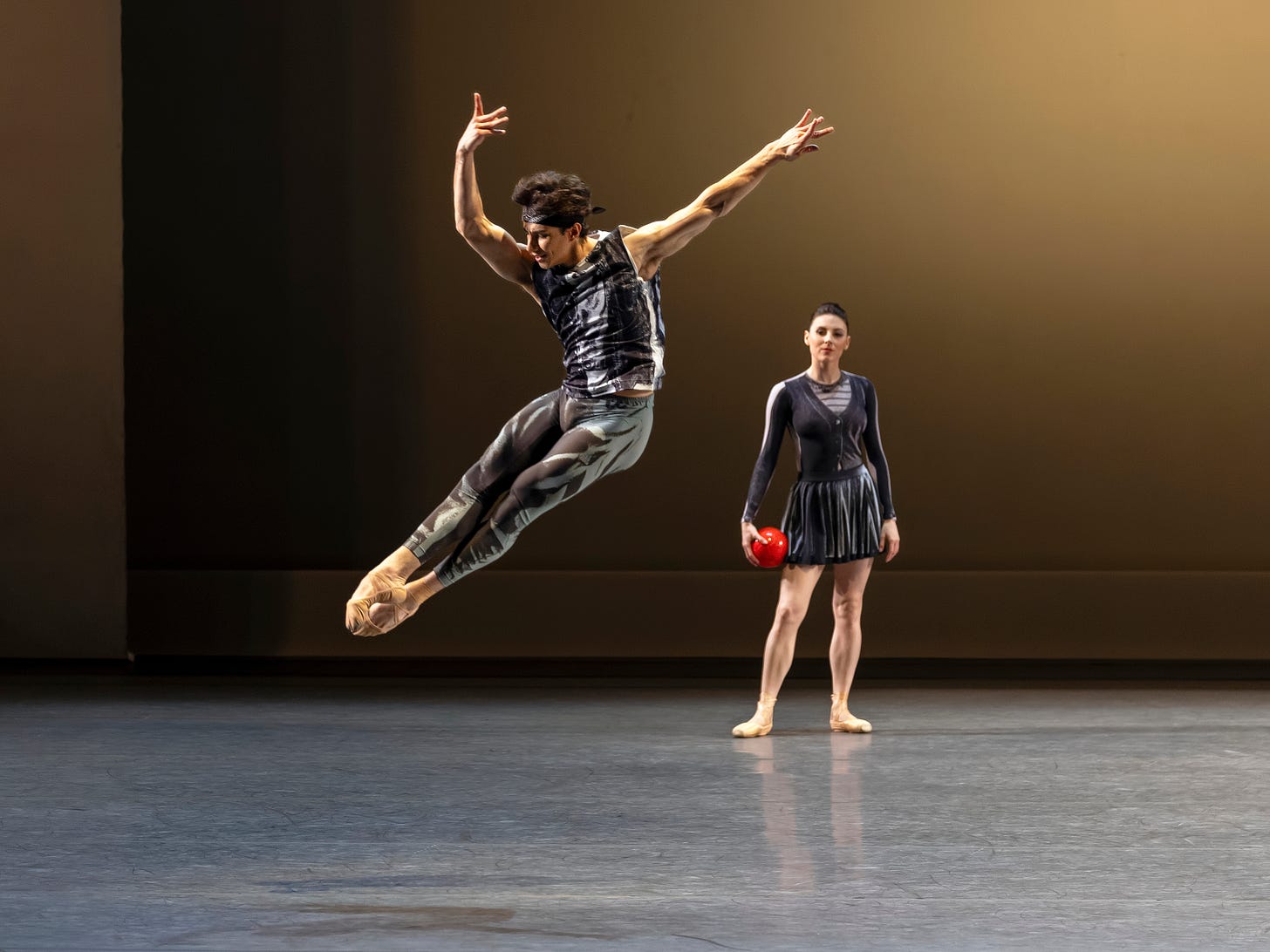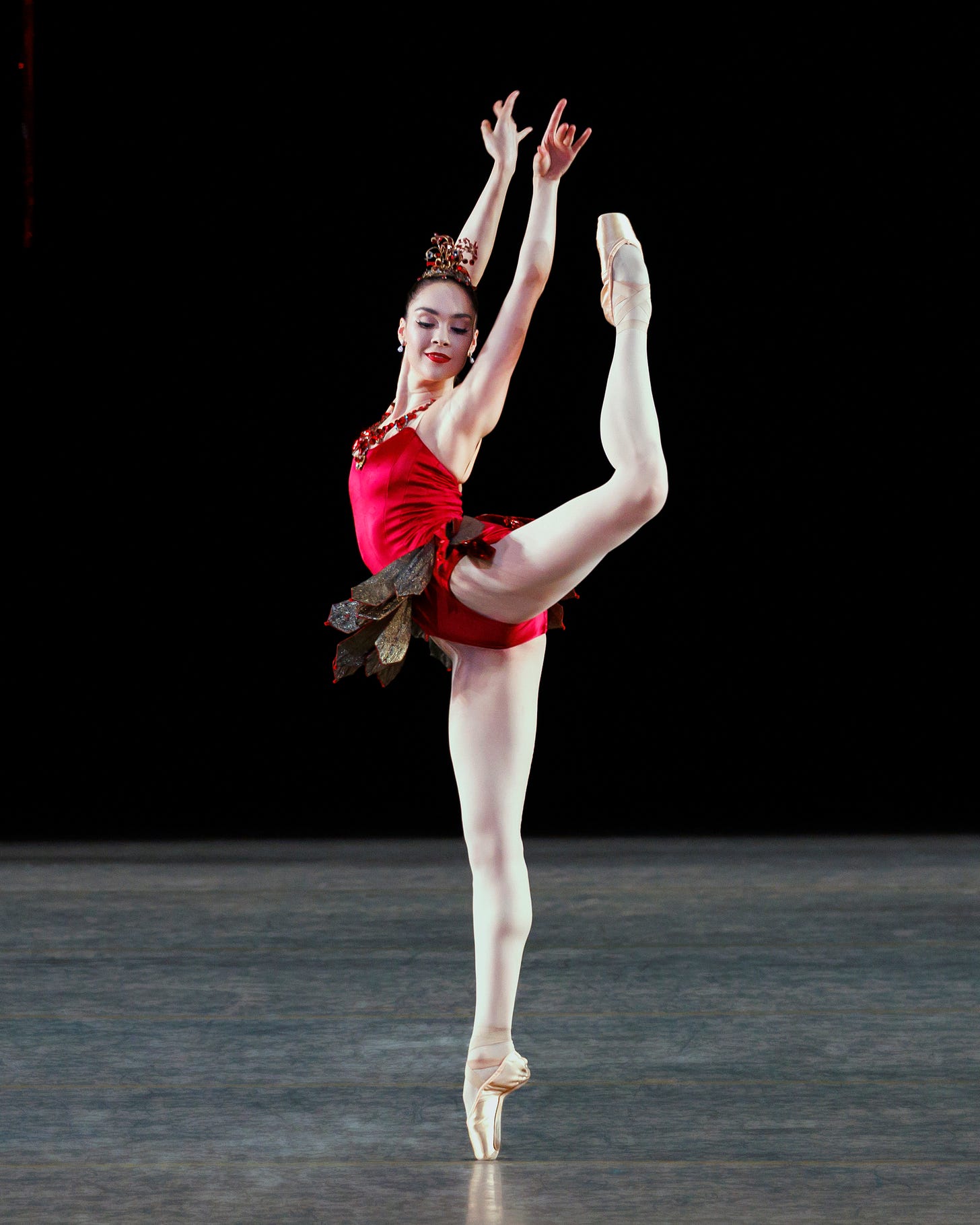Amy Hall Garner takes a bow with the cast of her ballet “Underneath, There is Light,” which premiered at the NYCB gala on May 2.
On May 2, New York City Ballet threw itself a party, as it does each spring. The crowd appeared to be in good spirits, and there were some beautiful dresses to be seen. In a stage speech, the company’s executive director Katherine Brown announced that the event raised the whopping sum of $3 million. Which is all to the good, in the sense that money ensures the survival of the company and provides funding for new works. For better or worse, this is how the artistic economy works.
The ballets unveiled at these galas can sometimes feel like pre-dinner entertainment, so it will be interesting to see how the two new works that premiered on this occasion will fare in the more mundane setting of a regular night at the theater. On first viewing, one, Justin Peck’s pas de deux for Tiler Peck and Roman Mejía Dig the Say, was a true gala bauble meant to show off the skills and star power of two immensely capable and charming dancers. (They also happen to be a couple.) The other, Underneath, There is Light, introduced the New York City Ballet audience to a much-in-demand choreographer, Amy Hall Garner.
Garner left nothing unsaid or un-used in this, her first work for the company. The impression was one of profusion: of dancers, of musical lushness, of movement. Underneath, There is Light is made up of four sections, each but the last set to driving music, each by a different composer. The earliest is a passage from Ottorino Respighi’s 1924 “Pines of Rome”; the most recent is excerpted from Michael Zev Gordon’s “Diary Pieces,” composed in 2018. Most of the dances have a strong pulse. Garner clearly means to make a big impact. The dances are highly driven, teeming with movement, bursting with energy. On the positive side, Garner taps into the dancers’ energy and clarity. Their stamina is impressive; their capacity for detail and precision, even at high velocity and over long periods, is even more impressive.
Chun Wai Chan, Mary Thomas MacKinnon, and Gilbert Bolden III in Amy Hall Garner’s “Underneath,There Is Light.” Photo by Erin Baiano
On the other hand, the down side of this energetic approach is both a lack of nuance and a kind of freneticism. (The same was true of Garner’s first piece for Alvin Ailey last year, Century.) The opening, “Run to the Edge,” introduces waves of dancers who fly across the stage. The Latin-inspired “Cumbia y Congo,” brings more of the same: spins and runs and flying jumps and folding movements of the torso, complemented by little details for the arms and hands. Speed and boldness eventually become an aimless, though orderly, deployment of energy. Within this furious maelstrom, individual dancers are given solos, little moments to shine, and shine they do, though it is difficult, in all this flurry, to get much of a sense of what, if anything, these solos are trying to express.
After what appears to be a driving finale, the ballet enters its final and most effective passage. Here, Garner finally takes a breath. This section, set to Respighi’s “Pines of the Janiculum,” suggests what Garner might do in more relaxed circumstances. Respighi’s mysterious, melting melodies for clarinet and impressionistic flurries of notes for the piano, combined with the dance’s moonlit ambiance (lighting by Mark Stanley), create a dream-like atmosphere, through which the dancers, in particular the women, float like sylphs (and later, birds), stretching through space. The men move in slow motion around them, like nocturnal butterflies. Above hangs a white panel, like a glowing moon (also by Stanley). In the earlier sections, this multi-paneled mobile is a distraction, but here it augments the mood, as do Marc Happel’s gorgeous, lithe yellow dresses for the women. The dancers become remote, elongated, fluid figures. Here, the supple Miriam Miller, gently lyrical Alston McGill, and incisive Mary Thomas MacKinnon make more of an impression. It is MacKinnon, with her intense focus and pared-down, uncompromising movement quality, who finally supplies a much-needed hint of inwardness to Underneath, There is Light. What is she dreaming of, you ask yourself, as she walks forward, through the glow.
The stars of Justin Peck’s “Dig the Say,” Roman Mejía and Tiler Peck, in costumes by Humberto Leon. Scenery and lighting by Brandon Stirling Baker. Photo by Erin Baiano.
Justin Peck’s Dig the Say, named for the music to which it is set, a lively quartet by Vijay Iyer performed here by the PUBLIQuartet, is much more explicitly a gala piece. (He’s been busy, ok? His musical, Illinoise, was just nominated for a Tony.) The music is rhythmic and syncopated, with jagged strings, abrupt starts and stops, and, toward the end, clapping and stomping by the musicians. One of its inspirations is the music of James Brown. It includes a section called “I Carry the Ball,” whose title supplies the ballet’s opening conceit: duet as playful game of hand-ball. Tiler Peck and Roman Mejía take turns bouncing a ball against a wall, before launching into highly virtuosic solos. At one point, Mejía tosses the ball offstage; what flies out of the wings is not the ball, but Peck herself. The joke is repeated three times.
Peck stretches and leans, defying gravity, and beats her legs together in the air in jumps, showing off her control, speed, finesse. Mejía does spins, descending to one knee or stopping on a dime, and changes shapes as he flies through the air. She is stylish, he is charming and carefree. Justin Peck even throws in a one-handed overhead lift, a trick not often seen on the stage of New York City Ballet. The duet hinges on the idea of playful competition, highlighting the bravura of both dancers. They deliver.
The evening opened with a performance of George Balanchine’s Rubies, led by Megan Fairchild, Anthony Huxley, and Mira Nadon. Blithe, playful, seemingly in her own world, Nadon dominated the ensemble as she vamped, kicking her leg high into the air like a showgirl and shaking off the hands of four admirers who attempted to partner her. She barely noticed their existence. Fairchild and Huxley were frisky, quick, and light in the pas de deux. Rubies, one third of the longer Jewels ballet, fits well into the gala format. But it’s also more than the sum of its parts; it draws on art deco design, and jazz, and tango, and horse racing. It contains a multitude of ideas. Something to consider at the next gala, perhaps.
Mira Nadon in “Rubies,” by Erin Baiano.








Yes, Alvin Ailey's choreography didn't play with the music, was a movement on every beat, except for his masterpiece, "Revelations," about his experience in a black church
And a clever title too